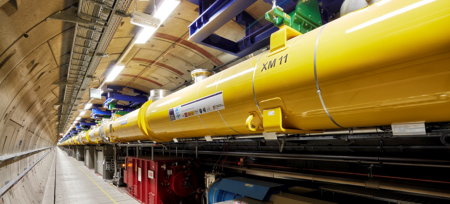The construction of the European XFEL in Hamburg, one of the most significant European research infrastructures has reached an important milestone: the 2.1 km long underground electron accelerator of the large facility has become operational. It consists of 98 resonators arranged serially along a distance of 1.7 km that, for the time being, accelerate electrons to an energy of 12 GeV (12 billion electron volts), a figure to be increased to 17.5 GeV during the next few months. The resonators are made of the metal niobium and are operating at ‑271 °C, close to the absolute zero temperature where niobium becomes a superconductor, i.e. it completely loses its electric resistivity. This is presently the world’s longest superconducting linear particle accelerator.
The accelerated electrons will enter an about 200 m long series of magnets of special arrangement, the so-called undulators in which 27000 ultrashort X-ray flashes per second will be created. The properties of the flashes will be similar to those of laser light and will have a brilliance that is a billion times higher than that of conventional X-ray sources; such facilities are called ‘free-electron lasers’. Scientists will perform experiments with these flashes of about 10 keV (i.e. hard X-ray) photons at the experimental stations being constructed at the end of the altogether 3.4 km long X-ray laser. Atomic details of viruses will be mapped, the molecular composition of cells will be deciphered, three-dimensional ‘photos’ of the nanoworld will be taken, fast chemical reactions will be ‘filmed’, processes such as those occurring deep inside planets will be studied, and the list could be continued long. The first user experiment will take place in the fall of this year.
Planning of the European XFEL started twenty years ago. The construction needed more than seven years, however the extension will go on also in the operational phase. The construction of the X-ray laser was taken over by 11 countries including Denmark, France, Germany, Hungary, Italy, Poland, Russia, Slovakia, Spain, Sweden and Switzerland. Germany and Russia contribute 58% and27 % of the total costs (at 2005 price levels), respectively. Hungary, as a full member bears 1% of the costs. Measurements and experiments can be performed by concerned researchers to the extent of the beam time provided by the share of the given partnering country
Hungarian scientists have been using accelerator-based X-ray sources for analytical and materials investigations since the eighties; most of their experience stems from the largest European synchrotron, the ESRF in Grenoble. Therefore it can be expected that, after completed construction of the experimental stations, they will also prove to be successful users of the European XFEL. Presently, two Hungarian research teams at the Wigner Research Centre for Physics, Hungarian Academy of Sciences are planning to become one of the first users of the facility. New achievements may also be expected from other researchers in the fields of molecular biology, genomics, medical diagnostics and treatment applications, nanotechnology and relating material sciences etc.
 |
| Photo by Heiner Müller-Elsner / European XFEL |
Subscribe for the monthly newsletter of the NRDI Office to keep updated on Hungarian RDI news and international aspects: Newsletter in English
Further information and previous updates on Hungarian membership in international research infrastructures:
Sustainable development of research infrastructure
National Research Infrastructure Committee
The balance of international membership fees
Hungary joins ELIXIR, the most extensive European infrastructure for life-science information
Envoy extraordinary for the international utilisation of the ELI laser research centre capacities in Szeged
V4 cooperation to jointly utilise research infrastructure and promote the expert evaluation of programmes
Significant Hungarian R&D export to the European Spallation Source






